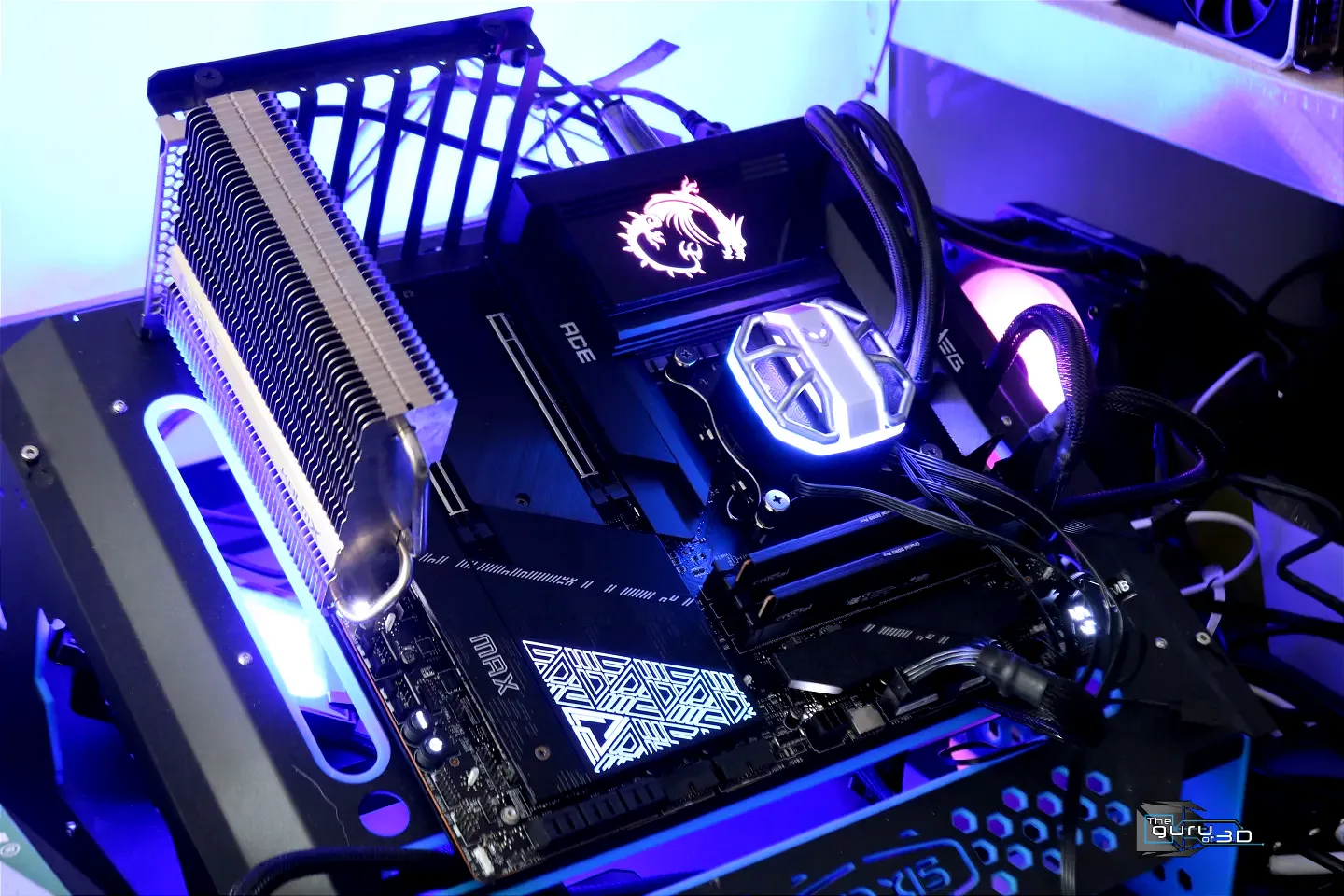Words & Conclusion
Final Words
We found that the Z790 ACE was something of a masterpiece at the time. This upgraded MAX model retains that status; however, the changes are minimal. In the BIOS, there are added compatibility improvements and some new tweaking options. But the most significant change on the box is undoubtedly the support for WIFI7 and Bluetooth 5.4. Regarding WIFI7, the IC used is from QUALCOMM. While we haven't had the opportunity to test WIFI7 yet, we must note that WIFI6E provided the best connectivity we've seen for any motherboard supported so far. We eagerly anticipate testing its performance as WIFI7 routers and access points become available, as the potential is quite promising. MSI offers a feature-packed motherboard with exceptional build quality. Furthermore, it delivers outstanding performance, making it one of the fastest platforms we've used with the 13900K (although, at the time of testing, we had not yet received our 14900K).
The ACE MAX is a visual delight that exudes quality and performance. We previously tested it with our 7600 MHz DDR5 kit, and it ran flawlessly. Note that the evaluation of the DDR5 kit will be conducted separately. For your investment, you receive an E-ATX Gaming motherboard with PCIe 5.0, DDR5, 24+1 Power Stages, dual 2.5Gb LAN, Bluetooth V5.4, 5x M.2/NVMe SSD slots, and 2x Thunderbolt 4 ports, as well as WiFi 7 (which is very promising) and LGA 1700 support for Intel 13th & 12th Gen processors. In terms of pricing, this motherboard comes in at $699 USD and likely will replace the regular ACE. It's worth pondering how PC gaming has become so expensive. We believe that Z790 motherboards should fall in the range of 200 to 300 EUR, as most motherboards offer similar performance. Alternatively, a firmware-updated Z690 motherboard can perform just as well and is likely to be more budget-friendly in the near future. If you opt for DDR4 memory, you'll achieve 98% of the same performance.
Performance
We utilized a DDR5 6800 kit for this review, and that revealed spectacular bandwidth; albeit you'll gain some performance we don't think it's worth the money though to spend too much on high-frequency kits though—more on that in a separate review of course. The performance, then, this motherboard is built and refined for just that. That goes from processor and memory performance towards WIFI6E and Ethernet with even dual 2.5 Gbps links. We do have to say that we're a little surprised to not receive a 10 Gbps ethernet connector in this price class, that or even 5 Gbps. The ACE comes with a very sophisticated power phase arrangement, pro overclockers will love this. Our take on PCIe 5.0 is this: at this time and stage, it's not needed for graphics cards, and while for soon-to-be-released SSDs it might be a nice gimmick, we doubt that other than sustained performance, things will be much different. For us, at this time it's not a selling point.
DDR5 Memory
If you decide to go for a completely new platform, the elephant in the room is the cost of ownership. While DDR5 memory will get cheaper next year, you'll likely pay a price premium. For intel, we recommend at least 5200 MHz; however, much like AMD, 6000 MHz might be a nice sweet spot. Stability-wise, we had no issues, we took a random 6000 MHZ kit, and it worked beautifully. We also tested a 7200 MHz kit without any hiccups.
Energy efficiency
We tested with a Core i9-13900K, a processor rated at a staggering max 253 Watts TDP (PL2) states. That does not mean the processor runs that all the time; however, for bursts of time when needed, it can pull that wattage. Overall the temperatures peaks high, but only for a short amount of time. We see better overall values than what AMD is offering with the 7950X. You could cool this processor with a premium heatpipe-based cooler; however, we'd advise a nice LCS kit. Our processor reached 97C for a short burst of time and then settled in the 80-85'ies C under a fully threaded load.
The conclusion
We remain somewhat baffled about the current pricing of premium motherboards. The Manufacturer's Suggested Retail Price (MSRP) for the ACE MAX is set at $699 USD. When we solely consider the hardware itself, we must acknowledge that the ACE MAX is close to being a masterpiece. The positioning of the ATX power connectors is rather unconventional, the aRGB connector is we feel located on the wrong side of the motherboard, and in this price range, a 10 Gbps Ethernet port was an expectation. Aside from that, it checks all the other boxes (excluding pricing). The ACE MAX offers an impressive array of features, including five NVMe SSD storage options, WiFi 7, and Bluetooth 5.4 support. Thunderbolt is also included. The VRM design is more than sufficient, supporting PCIe Gen 4.0 and 5.0. The platform is even capable of handling the fastest memory speeds, up to 8000 MHz. In terms of hardware, this motherboard is solid; we encountered no stability problems. The WiFi 6E on both the 5 GHz and 6 GHz bands is exceptionally fast, and we plan to update on WiFi 7 when available. The 2.5 Gigabit Ethernet LAN ports perform admirably, complemented by the 105A Power Stages and extensive connectivity options, including M.2, SATA, USB, and Thunderbolt. It's an impressive package overall. This motherboard caters primarily to computer enthusiasts with deep pockets, rather than casual gamers or budget-conscious consumers. For those on a tight budget, this may not be a practical choice. However, every market has its niche, and the ACE MAX is firmly aimed at this particular segment. While it's an amazing piece of hardware, there may and will be better value options available. If you demand nothing but the best, it can be yours for $699 USD.
- Sign up to receive a notification when we publish a new article
- Or go back to Guru3D's front page.



